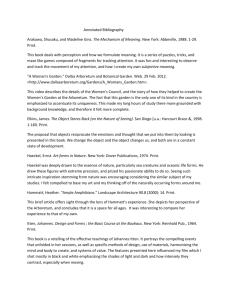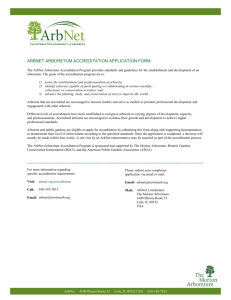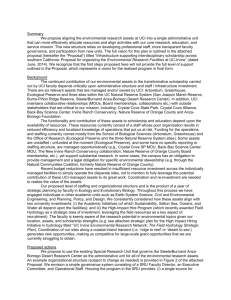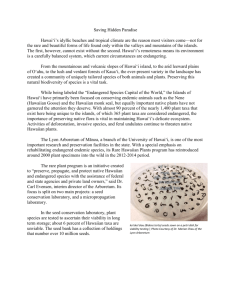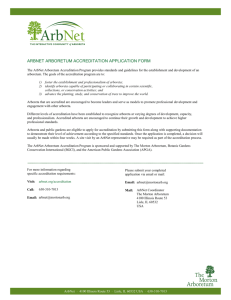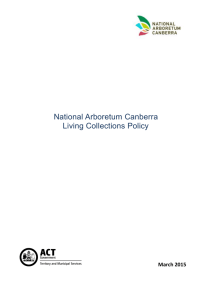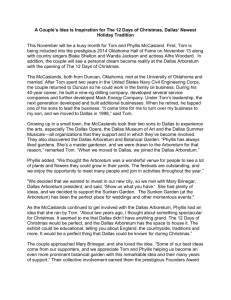ArbNet Arboretum Accreditation Application Form The ArbNet
advertisement
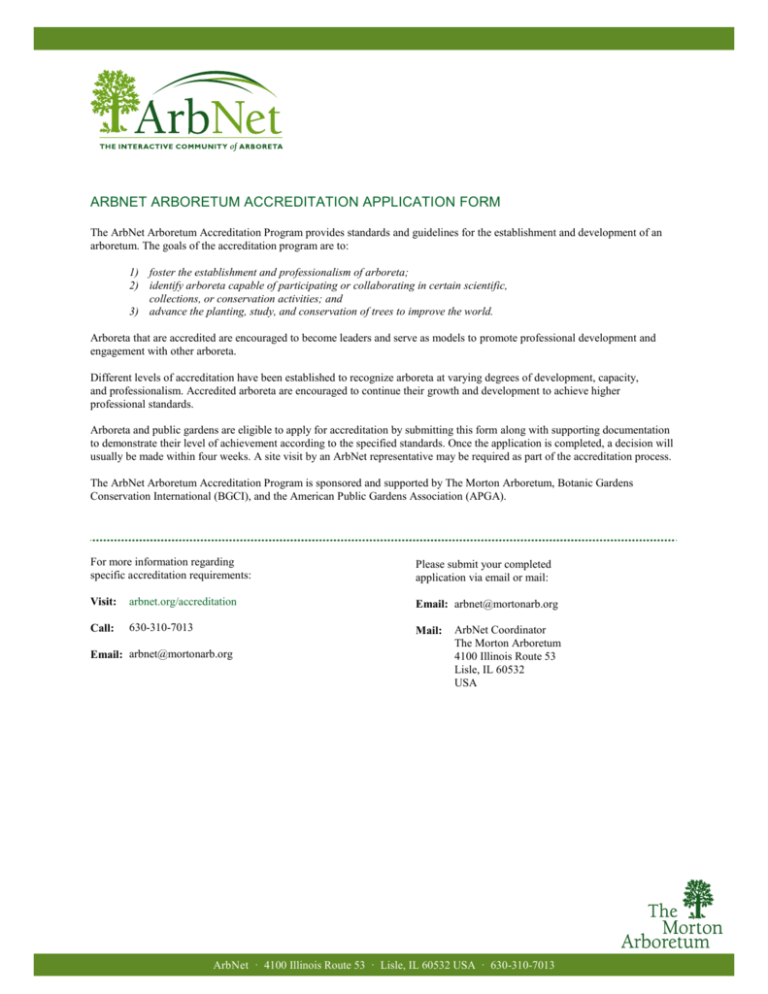
ARBNET ARBORETUM ACCREDITATION APPLICATION FORM The ArbNet Arboretum Accreditation Program provides standards and guidelines for the establishment and development of an arboretum. The goals of the accreditation program are to: 1) foster the establishment and professionalism of arboreta; 2) identify arboreta capable of participating or collaborating in certain scientific, collections, or conservation activities; and 3) advance the planting, study, and conservation of trees to improve the world. Arboreta that are accredited are encouraged to become leaders and serve as models to promote professional development and engagement with other arboreta. Different levels of accreditation have been established to recognize arboreta at varying degrees of development, capacity, and professionalism. Accredited arboreta are encouraged to continue their growth and development to achieve higher professional standards. Arboreta and public gardens are eligible to apply for accreditation by submitting this form along with supporting documentation to demonstrate their level of achievement according to the specified standards. Once the application is completed, a decision will usually be made within four weeks. A site visit by an ArbNet representative may be required as part of the accreditation process. The ArbNet Arboretum Accreditation Program is sponsored and supported by The Morton Arboretum, Botanic Gardens Conservation International (BGCI), and the American Public Gardens Association (APGA). For more information regarding specific accreditation requirements: Please submit your completed application via email or mail: Visit: arbnet.org/accreditation Email: arbnet@mortonarb.org Call: 630-310-7013 Mail: Email: arbnet@mortonarb.org ArbNet Coordinator The Morton Arboretum 4100 Illinois Route 53 Lisle, IL 60532 USA ArbNet · 4100 Illinois Route 53 · Lisle, IL 60532 USA · 630-310-7013 ARBORETUM: Name of Arboretum: Address or PO Box: City: State/Province: Country: ZIP/Postal Code: Latitude and Longitude: Acres: URL: Sample Application Level III ARBORETUM CONTACT (FOR ARBNET PURPOSES): Ted Tree Name: Title: Email: Phone: Fax: INDIVIDUAL SUBMITTING APPLICATION (IF NOT ARBORETUM CONTACT): Name: Title: Email: Phone: Fax: Horticulturalist TYPE OF ORGANIZATION: Please check all that apply: X Arboretum Historical Site Nonprofit Garden College Museum Cemetery City Park Town University Business City Zoo Golf Course Community Other: AUTHORIZATION AND VERIFICATION The chairperson or leader of the applicant arboretum’s governing board, organizational group, or authority (corresponding to Section I.b below) must approve this application, specifically verifying the accuracy and authenticity of the information it contains. Approval is indicated by placement below of this individual’s name, title or role at arboretum, and contact information. Authorizing/Verifying Governance Leader (other than individual submitting application): Name: Title: Email: Phone: Fax: p.2 CEO & President ArbNet · 4100 Illinois Route 53 · Lisle, IL 60532 USA · 630-310-7013 ARBORETUM ACCREDITATION STANDARDS Accreditation standards are outlined on the website, arbnet.org/ accreditation.html, and described in each of the following application sections. Please indicate which of the following standards have been met by the applicant and provide the information requested. Fulfillment of these standards is self-determined by the applicant. Arboretum accreditation level sought (check one): ___LEVEL I ___LEVEL II _X__LEVEL III ___LEVEL IV FOUR LEVELS OF ACCREDITATION Please use this chart as a reference. The levels of accreditation recognize arboreta with different degrees of development, capacity, and professionalism. p.3 ArbNet · 4100 Illinois Route 53 · Lisle, IL 60532 USA · 630-310-7013 1. GENERAL ACCREDITATION REQUIREMENTS (ALL LEVELS) a. Arboretum Plan Documentation such as an organizational plan, strategic plan, master plan, or other, that defines the purpose of the arboretum, its audience(s), the types of plants that are to be grown to achieve that purpose and serve those audiences, provisions for the maintenance and care of the plants, and provisions for the continuing operation of the organization through time with a clear succession plan. Sample organizational plans can be found at arbnet.org. Provide a brief description or outline of the type and scope of the plan for your arboretum. Attach the Master Plan document if possible. The overall direction, purpose and audience of the organization are dictated by our mission statement. The Arboretum’s living collections policy addresses in general terms the scope of plants to be grown in support of the mission and how those plants are utilized for education, research, horticulture, observation and aesthetic enjoyment. A landscape management plan (attached) addresses maintenance needs, priorities and schedules for specific Arboretum areas and specific plants or genera. b. Organizational or Governance Group A governing board, group of people, or authority that is dedicated to the arboretum plan and its continuation beyond the efforts of a single individual. Such an organizational/governance group will affirm fulfillment of standards and authorize participation as an accredited arboretum. Describe the nature of your governance board or authority and the number and type of individuals involved. Attach any relevant documents or policies relating to the Governance Group. The Board of Directors is made up of 10 individuals with varying skill sets that reflect the mission of the Arboretum and enable us to meet our needs. The board is made up of both founding members and others from all across the country who share an interest in the success of the institution. A mix of individuals with financial, botanical/horticulture, event-planning and marketing backgrounds compromise the board. Holding four interactive board meetings a year, along with bi-monthly sub-committee meetings, the board has clearly defined roles. The authority and decision making mechanism are the By-laws which are reviewed every three years. c. Arboretum Collection The number of tree and woody plant species being grown in accordance with the arboretum plan. Plants in the arboretum’s collection must be labeled in some way to identify them taxonomically, including scientific name and cultivar if applicable, and documented in some way so that information on their acquisition (source or origin, date of acquisition, etc.) is available for access. Minimum numbers are: 25+ Species (Level I) 100+ Species (Level II) 500+ Species (Levels III and IV) Indicate the number of trees/woody plant species in the collection and describe the method for labeling and documenting the plants. Provide the link to your collections database and indicate if it is shared in a searchable, open-access database, such as BGCI PlantSearch (http://www.bgci.org/plant_search.php). If your collection species list is not shared or accessible online, please attach the list with your application. List any special taxonomic, geographic, ecological, or conservation collections of note (e.g. oaks; Acer; dwarf conifers; halophytes; woody plants of Madagascar; etc.): There are over 1,580 taxa in the collection represented by more than 2,000 accessions. Every accession has a unique accession number that is linked to accession and collection details in our BG-Base plant records database. You can access that database by going to www. Arboretumdatabase.com. We also share our database with BGCI. The accession number is comprised of two parts: the first is the year in which a particular propagule entered the records and the second is the order in which a particular propagule was received that year. All plants are labeled with an embossed aluminum accession tag with the scientific name and accession number. Through the use of a new laser engraver we are in the process of transitioning to an engraved bi-laminar plastic accession tag with more extensive accession data, including scientific name, common name, accession number, family, source, how a propagule was received, and, if of wild origin, where it was collected. Each year, more and more plants are marked with a more p.4 ArbNet · 4100 Illinois Route 53 · Lisle, IL 60532 USA · 630-310-7013 visitor-friendly and larger display label. These labels display scientific, common and family names and accession number. Display labels bearing the five trees of our logo indicate that the plant is our introduction. d. Arboretum Staff or Volunteer Support i. Level I Employees or volunteers who ensure fulfillment of the arboretum plan and provide for the basic needs of the arboretum collection and functions of the arboretum. Describe the scope of staff or volunteers engaged in or supporting the work of the arboretum. ii. Levels II, III, & IV One or more paid arboretum employees who have job responsibilities that specifically include management or operation of the arboretum in fulfillment of the arboretum plan. Describe the staff responsible for management or operations of the arboretum, including staff dedicated to educational programming for Levels III & IV. The Arboretum is led by the Executive Director. Support staff includes the Administrative & Financial Officer and Membership & Outreach Coordinator. The grounds are maintained by the Collections & Grounds Manager who leads the Horticulturist/Arborist, Horticulturist/Plant Propagator, Collections Management Intern and Summer Interns. The Children’s Education Coordinator and her Assistant lead the school programs. We are also blessed with a multitude of volunteers who aid us in daily operations of the arboretum to give us a total of 2,488 hours of work in 2011. Our Visitor Center, which is open Memorial Day to Columbus Day, is staffed primarily by volunteers (31 volunteers, 880 hours) who work in two shifts daily. Volunteers also give the daily 2pm tour of the Arboretum grounds during the same season (26 volunteers, 210 hours). Our school education program has a total of 13 volunteer school guides who worked 302 hours during the annual school program. The greenhouse utilized 90 hours of time from 3 volunteers. A 13-member core grounds volunteer group worked a total of 696 hours in 2011. The balance of hours was split mainly among diverse administrative functions. iii. Levels III & IV A dedicated curator, or curator-equivalent employee, who is focused on the care and development of the arboretum collection, in accordance with the arboretum plan and collections policy. Provide the name and job title of the curator or curator-equivalent employee. Charles Curator, Collections and Grounds Manager e. Arboretum Public Dimension A public dimension that includes some level of public access, and at least one public event or educational program each year focused on trees or arboretum purposes (for example, an Arbor Day observance). Describe how the arboretum is open or accessible to the public, and name and describe the public events or programs offered. The Arboretum is open to the public from sunrise to sunset daily. Located in a seasonal economy, the arboretum offers a daily tour of the grounds from Memorial Day to Columbus Day. There is no entrance fee, but rather a suggested donation of $5. During the season there are weekly lectures on Wednesday evenings and various workshops open to the public. Opening day offers plants for sale and plant oriented workshops: there is no admission fee for this event. Plants are offered for sale between Memorial Day and Columbus Day. p.5 ArbNet · 4100 Illinois Route 53 · Lisle, IL 60532 USA · 630-310-7013 2. COLLECTIONS AND EDUCATION (REQUIRED FOR LEVELS II, III, AND IV) a. Arboretum Collections Policy A collections policy describes the purpose, development, and professional management of the plants in the arboretum collection, in accordance with standards developed in the public garden and museum fields. Such a policy and related practices includes a rationale for holding the particular collections of the arboretum, collections inventory, and record-keeping practices. Examples are available on the ArbNet website (arbnet.org). Describe and outline the elements of the collections policy and attach the document if possible. Statement of Collection Policy The Arboretum actively seeks to acquire and accession woody plants representing taxa that will increase the genetic diversity of its existing collections and that are simultaneously adapted to our climate and exhibit superior ornamental qualities or unusual botanical features. New acquisitions will include woody trees, shrubs, and climbers as well as herbaceous perennials that augment collection diversity for the purposes of research, teaching, plant conservation and the development of the landscape. While new taxa are sought from around the world, those native to eastern Asia and particularly to Japan – along with those indigenous to North America – form the primary focus of collecting interest. Within the latter region, the Arboretum has an especial interest in the woody plants of the Atlantic Coastal Plain, which includes the native flora of our area. In every instance, accessions of documented provenance and/or wild origin are sought. Given constraints of space, the Arboretum endeavors to be selective in its program of plant acquisition and aspires to bring together a diverse collection of rare and unusual plants that will be of interest to the layman as well as the keen horticulturist and botanist. In acquiring new accessions, the Arboretum intends to be ever-mindful of current collecting etiquette and the necessity that it serve as a steward of our native vegetation in preventing the introduction of potentially invasive species. The living collections policy itself goes into the details of the processes involved with accessioning, deaccessioning, distributing materials, external use of the collection and other curatorial practices. (Actual collections policy attached) b. Enhanced Educational and Public Programming Enhanced or substantial educational and public programming beyond the basic level required for Level I accreditation. Programs must be related to trees (e.g. tree identification, ecology, conservation, collections, or some other tree-focused aspect of the arboretum mission or master plan). i. Level II Enhanced Education Program Describe the educational and public programs offered by the arboretum. Include evidence of at least two outcome-based education programs (e.g. provide program description, syllabus, hand-outs, worksheets, tour script, tour map, etc.). ii. Levels III and IV Substantial Education Program A substantial program of education related to trees and woody plants, conservation, and other related topics. Provide a description of your overarching program plan including your education program strategy, number of outcome-based education programs, and explain how they are evaluated. The Arboretum has a Youth Education Program that was developed to work within the state Curriculum Guidelines. Grades from pre-school to 6th grade from all area schools participate in this place-based learning program. Program coordinators, along with volunteer school guides, present a program in the classroom before the groups visit the arboretum to prepare them for what they will be doing during their supervised visit. p.6 ArbNet · 4100 Illinois Route 53 · Lisle, IL 60532 USA · 630-310-7013 The Arboretum has had a full time employee dedicated to public education and outreach for the past 15 years. The primary audience has been adults in the community, and for the past five years we have had a significant children’s ed. program as well. The focus is not just on trees, but on natural history, conservation, environmentally sound landscaping and the importance of native plants. On a yearly basis we have averaged about 20 adult programs and 15 children’s programs of all different types. We have a regular series of walks and workshops each year that cover tree identification (with and without leaves), woody plant pruning, autumn color and spring woodland wildflowers. Less frequently we cover topics like invasive species, proper planting techniques and starting plants from seeds and cuttings. Examples of special programs include guided walks through our collections by our curator, director and botany professors highlighting special plant groups or uses, for example the enthnobotanical aspects of our native trees and shrub as used by local Native Americans. Recently we hosted an all day workshop on moss identification with field and lab components, and a workshop on identifying seaweeds and preparing various meals with them. For a number of years we sponsored a Bonsai and Asian Arts festival with a local bonsai club. The all day events included bonsai exhibits, workshops, sales of plants and materials and displays of Asian prints and paintings from the College’s Chu-Griffis Art Collection. Our main educational event for professionals is a two day intensive ecological design symposium for landscape architects, landscape designers and others in the green industry. We have produced this event consecutively for over 20 years in conjunction with the Univ. of ABC. Over 120 people attended the 2013 symposium which aims to educate design professionals in the general subjects of native plant horticulture and ecological processes. Woody plants are always part of the subject matter at these events. Our website has an important education function, with information about the content of our collections and our natural areas. There is a “Find a Plant’ search function on the website where one can find the location of the trees and shrubs in collections. 3. REQUIRED FOR LEVEL III ONLY Please complete if you are interested in acquiring a Level III accreditation. If you are interested in a Level IV accreditation, please skip this section and complete only the Level IV section below. a. Collaboration A professional capability to collaborate in some way with other arboreta or relevant organizations (e.g. public gardens, universities, local government, NGOs, student groups, etc.), preferably with evidence of existing collaboration. Examples of collaborations may include plant evaluations, research projects, in situ or ex situ conservation projects, educational programs, exhibits, public events, interpretation, collecting expeditions, plant exchanges, professional meetings, and co-authoring scientific research papers. Provide examples of existing collaborations with other arboreta and related organizations. Please describe your capacity to collaborate. The Arboretum has collaborated with several other public gardens on plant exploration and seed collection expeditions. Two trips to Japan in 2005 and 2007 were joint efforts between with Quarryhill BG, RBG Edinburgh and Howick Hall Gardens; the Morris Arboretum participated in the 2007 trip. Trips to the southeastern U.S. have involved staff from PHA, Mt. Cuba Center, Atlanta BG and Birmingham BG. The Arboretum is collaborating with the local Land Bank and the Sheriff’s Meadow Foundation (both conservation groups) to catalog and document the flora of our County. We are a member of the North American Plant Collections Consortium (NAPCC) and hold the national collection of Stewartia. Two members of the staff have served (and one currently does) as the NAPCC Northeast Region Coordinator. We are a part of an informal group of public garden professionals and like-minded nursery people that make up the p.7 ArbNet · 4100 Illinois Route 53 · Lisle, IL 60532 USA · 630-310-7013 Stewartia Working Group, the purpose of which is to document, catalog and study Stewartia, particularly the two North American species. Another element of this group is to further develop propagation and horticultural techniques. The arboretum is part of a network of official holly arboreta through the Holly Society of America. We continually seeks to develop formal and informal relationships and collaborations. Please indicate whether you are a member of the following professional organizations or indicate other professional societies in which you participate. _X__BGCI Botanic Gardens Conservation International (bgci.org/global/members) _X__APGA American Public Gardens Association (publicgardens.org/content/membership-central-0) _X__NAPCC North American Plant Collections Consortium (publicgardens.org/napcc) _X_Other: Holly Society of America b. Collections Data Sharing Sharing of plant collections data with networked collections databases, such as BGCI’s PlantSearch Database (bgci.org/worldwide/plant_upload). Describe how the arboretum shares its plant collections data with one or more networked collections databases. The Arboretum shares its living collection data with numerous networked collections databases including: BG Base Multisite Search - http://rbg-web2.rbge.org.uk/multisite/multisite3.php BGCI Plant Search - http://www.bgci.org/plant_search.php Our plant collections database and maps are also available to the public on our website. c. Tree Science, Planting, and Conservation An active agenda related to tree science, strategic planting, or conservation. This agenda should include direct research or the facilitation of scientific activities beyond public educational activities, in which data are acquired to solve problems in tree science or tree conservation. Examples include conducting plant trials; habitat monitoring; detecting pests and diseases; hosting collections-based research projects; and conducting research in forest ecology, physiology, systematics, seed and tissue banking, horticulture and tree care. Describe the arboretum’s activities related to tree science, planting, and/or conservation. Include a list of relevant references, reports, or peer-reviewed journal articles. As previously mentioned the Arboretum participates in the ABC Society’s rare plant conservation program. Since 1952 the Arboretum has sponsored a long terms vegetation survey in our county Natural Area. Once every ten years a team of students led by a botany professor inventories all plants in four transects 20 ft wide by 1000 ft long. The survey has documented the effect of both slow, natural changes and catastrophic events including hurricanes and the collapse of the hemlock population due to wooly adelgid infestation. The data is currently being used by a plant ecologist to test various models of how invasive species spread on the landscape. A breeding bird census has been performed on a biennial schedule in the same 100 acre forest over the past 60years, allowing correlations to be drawn between forest and bird population changes. Multiple professional and popular publications have resulted from these long term ecological monitoring projects. The Arboretum is a cosponsor of the state Notable Trees project, which documents the largest individuals of all tree taxa growing in the state and also documents historic trees. Our director has chaired or co-chaired the small volunteer group for the past 30 years. An online, searchable database currently has records of 3276 trees in 440 taxa. The website is hosted by the arboretum and the paper archives are housed in the Arboretum Office. In 2004 the Arboretum began expanding early successional habitat with a program of clearing overgrowing fields and expanding grassland acreage by clearing and seeding areas that had been engulfed in invasive species. Scientists followed the progress of p.8 ArbNet · 4100 Illinois Route 53 · Lisle, IL 60532 USA · 630-310-7013 the seeded meadow and recently published a paper in The Natural Areas Journal that documents the projects first six years. In 2014 a committee led by our director published Native and Naturalized Vascular Plants of ABCState Checklist. This is the first updated list of the state’s native plants in 35 years. There have been a huge number of plant name changes and reassignments of plants to different families and genera over that time period, as well as new taxa entering the flora. The checklist serves as a reference to which of the 2,827 plants that are native to our state, and supplies the most current nomenclature. I have attached a list of articles that have been published. 4. REQUIRED FOR LEVEL IV a. Collaboration A professional capability to collaborate in some way with other arboreta or relevant organizations (e.g. public gardens, universities, local government, NGOs, student groups, etc.), preferably with evidence of existing collaboration. Examples of collaborations may include plant evaluations, research projects, in situ or ex situ conservation projects, educational programs, exhibits, public events, interpretation, collecting expeditions, plant exchanges, professional meetings, and co-authoring scientific research papers. Provide examples of existing collaborations with other arboreta and related organizations. Please describe your capacity to collaborate. Please indicate whether you participate in the following professional organizations or indicate other professional societies in which you are a member. ___BGCI Botanic Gardens Conservation International (bgci.org/global/members) ___APGA American Public Gardens Association (publicgardens.org/content/membership-central-0) ___NAPCC North American Plant Collections Consortium (publicgardens.org/napcc) ___Other: b. Collections Data Sharing Sharing of plant collections data with networked collections databases, such as BGCI’s PlantSearch Database (bgci.org/worldwide/plant_upload). Describe how the arboretum shares its plant collections data with one or more networked collections databases. c. Collections Conservation Institutional capacity, stability, and commitment to hold and safeguard plants of collections or conservation value on behalf of the collective interests of the profession. Confirm and describe the arboretum’s capacity and readiness to hold and safeguard plants of collections or conservation value. Describe specific collections of value and interest (i.e. endangered species) and include the percentage of wild-collected accessions in your collections as applicable. d. Scientific or Conservation Staff and Capability for Collaboration A scientific and/or conservation staff and capability to collaborate on scientific or conservation activities with other p.9 ArbNet · 4100 Illinois Route 53 · Lisle, IL 60532 USA · 630-310-7013 arboreta or organizations related to trees. Describe the scientific and/or conservation staff, and the arboretum’s capability to collaborate on sophisticated scientific or conservation activities. Include areas of research and a list of relevant publications. e. Conservation Role in Global Trees Campaign Specific consideration of a conservation role linked to the Global Trees Campaign (globaltrees.org). Describe how the arboretum is or could be engaged in conservation efforts related to the Global Trees Campaign. f. Other Scientific or Conservation Collaboration Please provide other information related to science and conservation activities that you would like to share. Provide additional examples of the arboretum’s existing collaborative scientific or conservation activities related to trees (i.e. habitat management) and identify any opportunities for future collaboration. Optional Accreditation Comments or Explanations: SUBMIT APPLICATION Please attach at least two photos of your arboretum (high resolution JPEG format in landscape orientation), as well as your institution's logo (JPEG format), with your application for use in Please submit your completed the accreditation press release and on the ArbNet website. application via email or mail: For more information regarding specific accreditation requirements: Visit: p.10 arbnet.org/ accreditation Email: arbnet@mortonarb.org Mail: ArbNet Coordinator The Morton Arboretum 4100 Illinois Route 53 Lisle, IL 60532 USA ArbNet · 4100 Illinois Route 53 · Lisle, IL 60532 USA · 630-310-7013 Call: 630-310-7013 Email: arbnet@mortonarb.org p.11 ArbNet · 4100 Illinois Route 53 · Lisle, IL 60532 USA · 630-310-7013
